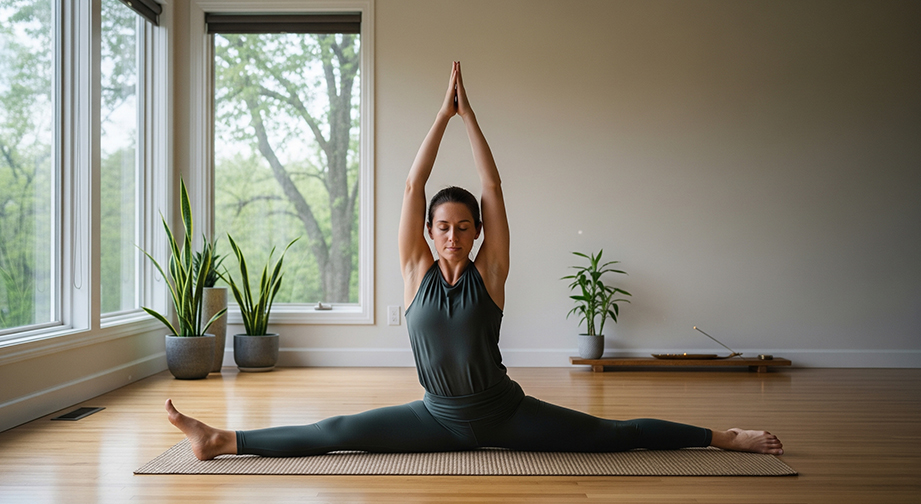Hanumanasana (Hanuman’s Pose) – A Gentle Guide to Splits in Yoga
Introduction
Hanumanasana, commonly known as Hanuman’s Pose or the full split, is a deep, invigorating posture in yoga that stretches the legs and opens the heart. The Sanskrit word ?uman refers to the monkey god Hanuman, known for his legendary leap; asana means pose or seat. This asana captures the courage and flexibility Hanuman symbolizes—a powerful reminder that big leaps start with small, mindful steps.
Essence: Hanumanasana is all about expansion and courage. It energizes the whole body while cultivating patience and focus.
Relatable Hook: Struggling with stiff legs, tight hips, or long hours of sitting? Hanumanasana is your gateway to newfound freedom and openness in your body!
Step-by-Step Guide to Hanumanasana (Splits)

- Start in a Low Lunge: Begin on your hands and knees, step your right foot forward between your hands for a low lunge (Anjaneyasana).
Inhale as you lengthen your spine.
- Slide Forward: Slowly slide your right foot forward and your left knee back, straightening both legs gradually.
Exhale as you lower yourself gently, using your hands on either side for support.
- Find Your Edge: Only go as far as your body allows—avoid forcing! Support yourself with yoga blocks under your hands or thighs if needed.
- Square the Hips: Keep both hip points facing forward. Engage thighs gently to protect your joints.
Steady breathing: Inhale to lift your heart, exhale to soften and surrender.
- Hold: Stay here for 5–8 breaths (30 seconds to 1 minute). Repeat up to 2 rounds per side.
- Exit Slowly: To come out, press into your hands, gently bend the front knee, and return to all fours.
- Modification for Beginners: Use blocks or bolsters under your thighs for support, or keep your front knee slightly bent.
- More Intensity: Advanced yogis can raise their arms overhead or fold forward, deepening the stretch.
Alignment & Safety Tips for Hanumanasana
- Focus: Square your hips forward; keep your back leg active and toes pointing straight behind.
- Avoid: Forcing the splits or collapsing your chest—use props for safe support.
- Safety: Avoid bouncing or jerking. If you have hamstring, groin, or hip injuries, or are pregnant, skip this pose or get guidance from a certified yoga teacher.
- Common Mistake: Allowing hips to splay or pelvis to tilt. Solution: Imagine your thigh bones hugging the midline.
- Listen to your body: Sensation is okay, sharp pain is not!
Benefits of Hanumanasana (Hanuman’s Pose)
Physical Benefits
- Deeply stretches hamstrings, hip flexors, and groin
- Improves hip mobility and flexibility
- Strengthens quadriceps, glutes, and core stabilization
- Enhances pelvic alignment and posture
Mental Benefits
- Builds patience and perseverance
- Heightens mind-body awareness
- Encourages presence, calmness, and stress relief
Energy/Chakra Connection
- Stimulates Root (Muladhara) and Sacral (Svadhisthana) Chakras
- Promotes grounding and creative energy flow
Contraindications
- If you have recent hamstring, hip, or groin injuries, or are pregnant, avoid Hanumanasana.
- People with chronic knee or lower back issues should use props and consult a yoga professional.
- Gentle Alternatives: Try Low Lunge (Anjaneyasana) or Supta Padangusthasana (Reclining Hand-to-Big-Toe Pose).
Beginner’s Tips & Variations
- Props: Place yoga blocks or a bolster under the front thigh and hands for support. A strap around the front foot helps keep your spine upright.
- Gentle Variation: Stay with your knee bent or practice Half Hanumanasana (Ardha Hanumanasana), keeping the back knee on the mat.
- Advanced Variation: Fold forward over the front leg or raise arms overhead for a deeper stretch and balance challenge.
How to Include Hanumanasana in Your Yoga Flow
- Best as a main practice or deep stretch after ample warm-up.
- Pairs well with: Low Lunge (Anjaneyasana), Pyramid Pose (Parsvottanasana), Standing Forward Fold (Uttanasana).
- Follow it with gentle hip stretches or Child’s Pose (Balasana) for recovery.
Mind-Body Connection
Hanumanasana calls for presence and humility—notice your breath, welcome sensations, and explore the mind’s reactions to challenge. Traditionally, this pose honors Hanuman’s leap, encouraging great faith and openness. It’s often associated with activating the root and sacral chakras, helping you find your personal power and creative flow.
Summary Box
- Asana Name: Hanumanasana (Hanuman’s Pose)
- Level: Intermediate (with beginner modifications)
- Focus Areas: Hamstrings, hip flexors, pelvis, core
- Duration: 30 seconds – 1 minute per side
- Best Time to Practice: Morning or post-warm-up
FAQs: Hanumanasana (Hanuman’s Pose)
Q: Can beginners do Hanumanasana?
A: Yes! With support, props, and gentle progression, beginners can safely approach this pose.
Q: How long does it take to achieve a full split?
A: It depends on individual flexibility—progress may take weeks or months. Practice patience and consistency.
Q: Should I practice Hanumanasana every day?
A: Not necessary. 2–3 times a week, as part of a well-rounded practice, is usually sufficient.
Remember, every journey begins with a single step—let Hanumanasana inspire your courageous leap!